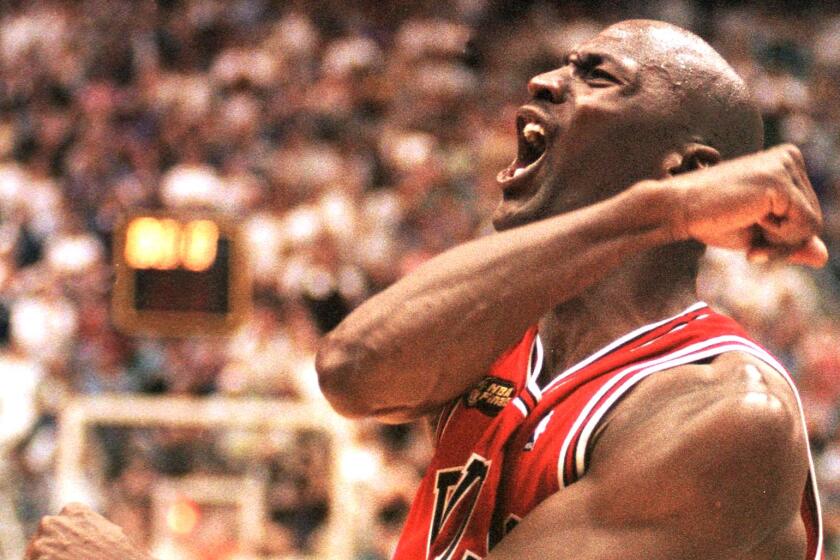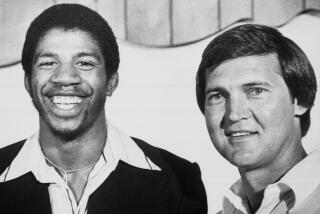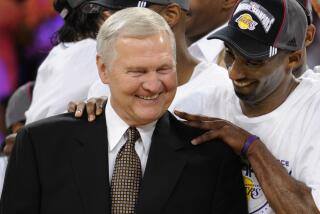A ‘home movie’ of Michael Jordan at his peak sat in the vault for 20 years. Until now
Michael Jordan was hesitant.
It was 1997, just before the start of the NBA season, which was anticipated to end with Jordan’s retirement and the breakup of the Chicago Bulls. Coming off their team’s fifth championship title, Jordan, fellow players Scottie Pippen and Dennis Rodman and coach Phil Jackson were expected to go their separate ways at season’s end, closing the book on one of sports’ greatest dynasties.
For the record:
5:09 p.m. April 19, 2020In an earlier version of this article, Mario Porporino was spelled incorrectly.
At the time, current NBA commissioner Adam Silver was the head of NBA Entertainment, which produced championship videos and other content. He had approached the game’s biggest star during the McDonald’s Championship in Paris about the possibility of embedding a camera crew with the Bulls to chronicle their last hurrah.
Silver had gotten the idea from Andy Thompson, a producer with the company. “I told him, ‘If we let the Bulls and Michael Jordan be broken up and retire without shooting a year in the life of this team and this franchise and this player, we will forever regret it,’” recalled Thompson, now vice president of NBA Entertainment. “For historical purposes, let’s get this in the can.”
Jackson, who was also in Paris, had no objection to the proposal, but Jordan wasn’t so sure. Sensing his wariness, according to Thompson, Silver told the superstar, “Look, the least that will go wrong is that you’ll have a great championship DVD or a great home movie for your kids in five years.” Jordan said yes.
What the film crew captured has never seen the light of day. Until now.
ESPN and Netflix’s docuseries “The Last Dance,” about Michael Jordan and the Chicago Bulls, is ambitious sports storytelling at a moment we’re aching for it.
After vanishing into a vault for more than 20 years, the candid “fly on the wall” footage from that winning season has finally resurfaced in “The Last Dance,” the epic docuseries about Jordan and the Bulls that premieres Sunday on ESPN. A co-production of the sports network and Netflix, the project also features archival video and in-depth interviews with Jordan, Pippen, Rodman, Jackson and numerous others.
Jason Hehir, who directed the docuseries, called it a revelation — and not only for sports fans: “This will tell the fans who saw the Bulls what they didn’t know, while also letting them see what Michael and the others were like. This is also for a generation that only know Michael as a logo on a shoe. We tell his story in a comprehensive way so they can understand who this team was and why they’re so revered to this day.”
Though Jordan and the Bulls are at the core of “The Last Dance,” the documentary transcends the sports arena, and can be compared to the Oscar-winning “O.J.: Made in America,” in which an extensive examination of the life of O.J. Simpson and his infamous murder trial served as the pivot point for a larger conversation about American culture, racial tensions and the obsession over celebrity.
“This shows the global commodification of American pop culture,” said Hehir. He pointed out that Jordan became a figure bigger than sports at a time when social media and the internet did not exist. That consuming celebrity would eventually take its toll on Jordan, as evidenced in the miniseries’ later chapters.
But most of all, the project is an invaluable document of the complicated dynamics of a team that will go down in history as one of the greatest of all time.
Said Thompson, “It’s an era and dynasty that encapsulated the best of the best in basketball, coaching, camaraderie, chemistry and a total commitment to winning and being excellent.”
Around 500 hours of footage of the 1997-98 season was shot, including news conferences and media scrums; behind-the-scenes moments on buses and planes and in locker and weight rooms; and game footage, much of it in slow motion. The crew included director of photography Michael Winik and soundman Mario Porporino.
If we let the Bulls and Michael Jordan be broken up and retire without shooting a year in the life of this team and this franchise and this player, we will forever regret it.
— Andy Thompson, vice president of NBA entertainment
“We recognized that it was captivating to see Michael, Scottie and people of that nature doing mundane things,” Hehir said. “We’re not used to seeing these folks out of uniform and as normal human beings. It’s ubiquitous now — everyone has social media followings and there’s a lot more access. As that season went on, they were obviously more and more comfortable with the camera crew. They really did become a fly on the wall.”
Many of the scenes show Jordan in practice interacting with his teammates — at times harshly. Said Hehir: “He had to make practice tougher than actual games so that his teammates would be ready to go into battle with anyone, especially those formidable teams in the Eastern Conference.”
“There were times you could see that he was really irritated,” Thompson said. “Everything was competition for Michael. He demanded excellence.”
Hehir said he was also fascinated by the footage from Jordan’s final NBA All-Star game at Madison Square Garden. During that contest, he faced off against a young player who idolized him, Kobe Bryant.
Jordan played on the team coached by Hall of Famer Larry Bird. In a pregame moment, Magic Johnson visits Bird and Jordan in the locker room.
Said Hehir, “The stars aligned for one of the most historic greetings in the history of the NBA at the mecca of basketball, Madison Square Garden. It’s these three Mt. Rushmore players interacting with each other. I rewound and watched that a few times.”
When Jordan hit the shot in the Finals that secured the Bulls’ sixth championship, Thompson said he “breathed this incredible sigh of relief that we captured the greatest season of the greatest player that ever played the game of basketball. It ended in storybook fashion. We had the holy grail of documentaries in the can. We were hoping it would become a traditional documentary for Showtime or HBO.”
The O.J. Simpson affair would seem to have long ago worn out its media welcome.
But the project hit a number of snags.
Jordan announced his retirement in 1999. The following year, an IMAX documentary, “Michael Jordan to the Max” was released, prompting NBA Entertainment to delay their film. When they resumed moving forward, Jordan unretired in 2001 and returned to play for the Washington Wizards in a season plagued by injuries and difficulties. During his final two seasons with the Wizards, the team never made the playoffs.
“It wasn’t a great ending and no one was thinking about the documentary,” Thompson said. “The film went into a vault while we were trying to figure out what to do with it.”
Interest faded more as Jordan moved in other directions, including management of the Wizards, and later, ownership of the Charlotte Hornets.
But as the 20th anniversary of the last Bulls championship approached, executive producer Mike Tollin, aware of the hidden footage, contacted Jordan’s production company about reviving the documentary, Thompson said. Soon afterward, the vault was opened and work began on producing the docuseries.
“It took the better part of 20 years for all of these things to fall into place,” Hehir said. “I was a high school senior when this was filmed. I feel so privileged to tell this story, and I felt such a responsibility to tell it the right way.”
More to Read
The complete guide to home viewing
Get Screen Gab for everything about the TV shows and streaming movies everyone’s talking about.
You may occasionally receive promotional content from the Los Angeles Times.








